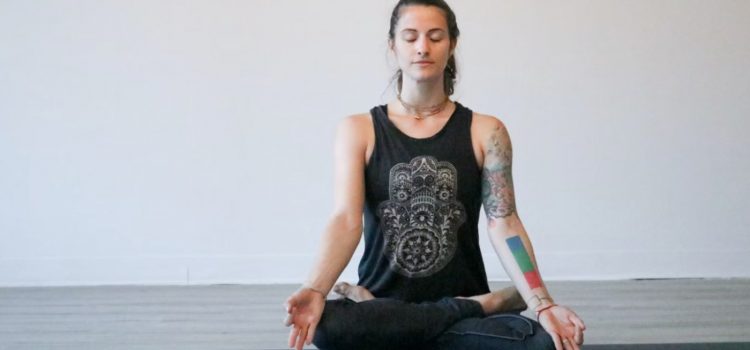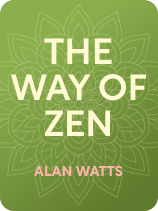

This article is an excerpt from the Shortform book guide to "The Way of Zen" by Alan Watts. Shortform has the world's best summaries and analyses of books you should be reading.
Like this article? Sign up for a free trial here.
Have you ever experienced Zen? Where’s the place to start? How is the Zen practice of meditation different from other methods?
Alan Watts says that there’s more to Zen than just a set of philosophical principles or a chronology of religious movements that you can understand on an intellectual level. Zen is also something that you can practice in your own life, at the level of your embodied experiences in the world.
Continue reading to learn how to practice Zen Buddhism according to The Way of Zen.
How to Practice Zen Buddhism
Although we’ll examine how to practice Zen Buddhism, we’ll also see why Watts argues that Zen isn’t a practice, per se. He explores the ways that Zen is often experienced, including the starting points for someone new to Zen. He also outlines the traditional practices of Zen, such as meditation, Koan training, recreation, labor, and breathing.
Why Is It a Mistake to Think of Zen as a “Practice”?
It’s common but not entirely correct to refer to Zen as a practice. Watts explains that to understand Zen, you have to experience it. But that doesn’t actually mean practicing it in a formalized, structured way. Paradoxically, you can’t truly practice Zen if you’re pursuing it as a goal. Similarly, Watts writes that Zen life begins with the understanding that you can’t practice Zen to become a Buddha because you are already a Buddha.
To experience Zen, you don’t need to practice any method in particular, nor do you have to do or think about anything specific. Watts explains that Zen isn’t a means to the end of awakening; instead, awakening, or satori, comes when you don’t have a goal in mind and are instead just experiencing the present moment in the concrete world.
(Shortform note: Not everyone agrees with Watts’s interpretation of the Zen teaching that you are perfect as you are and have just lost touch with your true nature. Journalist Jules Evans writes that according to the Buddhist nun Tenzin Palmo, you can glimpse your true nature, but you still need to practice to experience enlightenment. Evans explains that the risk inherent in following Watts’s philosophy is that you can become complacent, even egotistical, and fail to change your habits even when they cause suffering to you or to other people in your life.)
Where Should You Begin if You Want to Experience Zen?
It’s one thing to understand the basic principles of Zen, but it’s another to express those principles in the way you live. Watts offers two suggestions for beginning: The first involves stepping away from your abstract idea of the world, and the second involves seeking to experience the real, concrete world instead. We’ll look more closely at each of these suggestions.
Let Go of Illusions and the Goals That Follow From Them
To begin living a life of Zen, you first have to stop pursuing goals that reflect the abstract idea of the world. Watts writes that this means letting go of trying to experience the good without the bad: When you understand their relativity, then you can appreciate that there aren’t goals that can be set or achieved. Stepping away from illusions also means loosening your grip on trying to plan for a future that, according to Zen, doesn’t exist.
When you internalize the idea that there’s nothing to be gained or obtained in life, and nothing except the present, then you can realize that none of your abstract ideas about self-improvement remain relevant to your true self. The way you do things matters more than the specific things that you do (or goals you set). Watts writes that Zen doesn’t demand that you engage in any specific practice or course of action: You can experience Zen in any activity.
(Shortform note: If you’ve ever noticed that you don’t tend to feel happier after achieving a goal you’ve set for yourself—a phenomenon attributed to what psychologists call the hedonic treadmill—then the Zen idea of stopping yourself from pursuing goals might appeal to you. But it’s not quite as simple as dropping goals altogether: Buddhist monk Kinrei Bassis writes that the idea of “seeking nothing” is to stop looking for life to give you what you want, and instead focus on what it already gives you. This teaching also aligns with what psychologists recommend if you want to get off the hedonic treadmill: One way to do that is to pay attention to the positive things and acknowledge the things you feel grateful for.)
Experience the World Around You
The logical counterpart to stepping away from your abstract idea of the world is opening yourself to experiencing the real, concrete world instead. Rather than naming and classifying experiences, observe them and encounter them as they really are. Watts explains that Zen masters don’t spend their time talking about Zen. Instead, they experience Zen by focusing on the tathata, the suchness or the concrete reality, of the world around them.
(Shortform note: Experiencing the world directly is easier said than done. In The Happiness Trap, Russ Harris—who teaches Acceptance and Commitment Therapy (ACT), a mindfulness-based form of psychotherapy—writes that you have an observing self and a thinking self. Your observing self watches the thoughts you think, the sensations you feel in your body, and the world you observe with your senses. Your thinking self naturally interprets what your observing self experiences directly and distracts you from the immediacy of reality. By connecting with your observing self, you can stop identifying with your thinking self.)
How Is Zen Expressed?
It’s a basic principle of Zen that you can experience awakening at any point without having to participate in particular activities or meditate on specific ideas. However, Watts also writes that many traditional activities have historically been associated with the experience of Zen. We’ll describe the activities that have traditionally been used as an expression of Zen, including meditation, koan training, work, recreation, and breathing.
Meditation
One traditional Zen practice is sitting meditation, or za-zen, where you look at the world without thinking about it in abstractions. Watts explains that this practice helps you to see the “suchness” of the world since it involves letting your ideas about it fall away and experiencing reality as it exists right now.
Za-zen involves attending to what’s happening in the present moment, feeling a continuity between yourself and the world, and observing the absence of a boundary between your mind and the thoughts that run through it. This is a common way to express Zen, and Watts writes that Rinzai and Soto Zen monks spend a significant amount of time in the practice of za-zen. For them, the translation “sitting meditation” is literal: They practice za-zen sitting on a cushion in lotus pose.
(Shortform note: Watts’s interpretation of za-zen has attracted controversy. Tim Lott writes that, throughout his body of work, Watts dismisses za-zen as unnecessary to the practice of Zen, an interpretation Lott characterizes as “radical.” Similarly radical is Watts’s rejection of the traditional Buddhist idea of rebirth and the conventional understanding of karma as a system of rewards and punishments that transcends the human lifespan, according to Lott. But he explains that Watts saw his job in The Way of Zen as teaching the reader to think clearly, which is challenging when Zen is counterintuitive to someone with a Western perspective, and to help the reader accept that two contradictory ideas can be true at the same time.)
Koan Training
Another traditional way of expressing Zen is the sanzen, where pupils in the Rinzai School visit Zen masters to present their understanding of Zen stories: kung-an or koans. Watts explains that, in koan training, a student undergoes a series of 50 tests that take the anecdotes of historic Zen masters as their material. The student has to demonstrate that they understand the meaning of the koan. But, they can’t explain the story in just words: The demonstration must be nonverbal and intuitive, and the student discovers its form in the process of coming to understand the koan.
When the student has found an answer to the koan, they present it to the Zen master using a verse from the Zenrin Kushu, a compilation of Zen writings. The student carefully selects the verse to convey what they learned from the koan.
(Shortform note: Some experts say that koan training is one of the most meaningful practices in Zen Buddhism, even though the koans themselves are sometimes described as nonsensical. In The Three Pillars of Zen, Philip Kapleau Roshi writes that the purpose of koan training isn’t to lead us to enlightenment, but to “make us lose our way and drive us to despair.” That despair breaks down your assumptions and patterns of thinking so that you can discover a new perspective.)
Recreation and Work
Recreation and work offer another way to experience and express Zen. Watts explains that some Zen practices don’t emphasize za-zen; Instead, they teach people to use their everyday work and pursuits as a means of meditation. He notes that, traditionally, rituals like tea ceremonies, arts such as brush drawing and flute playing, and athletic pursuits like ju-jutsu, fencing, and archery all serve as a mode of meditation.
A traditional Japanese tea ceremony, or Chan-o-yu, translated as the “art of tea,” offers one way to express Zen. The tea ceremony is a ritual that, according to Watts, requires a total immersion in the present moment, as tea is prepared and served in a traditional but secular ritual.
(Shortform note: Other experts agree that the Japanese tea ceremony is rooted in Zen thought and intends to bring participants’ attention fully to the present. It takes 10 years of study to fully master the ritual of the tea ceremony and the 37 steps it takes to brew, serve, and drink tea in the ceremony.)
Traditional forms of art offer another way to understand and experience Zen (whether you’re practicing the art or just appreciating it). Watts characterizes Zen art as an expression of the artist’s experience of the present moment. Sumi-e, a style of calligraphic painting, expresses spontaneity in its depiction of natural scenes. Haiku, a short form of poetry, expresses the concrete reality of a moment in time, evoking its particular mood or sensation. These arts are intended to be practiced without making an effort, performed without separating thought from action and undertaken without setting goals for the practice.
(Shortform note: Today, the form of art that’s most closely associated with Zen is monochromatic ink painting. But all forms of Zen art are meant to evoke the simplicity and importance of the natural world, so they all express two concepts called wabi and sabi. While Watts characterizes these as moods, art experts say that they’re more amorphous and express concepts such as rusticity, melancholy, loneliness, naturalness, and age, so that the simple image in a painting or a haiku becomes evocative of something much deeper.)
Even work can serve as an expression of Zen when you approach it in the right mindset. Watts explains that historically, many professions and traditional crafts in Japan were regarded as lay methods for learning the principles of Taoism, Confucianism, and Zen.
(Shortform note: The importance of using your everyday activities to practice your spirituality recurs in many traditions. For example, in The Art of Happiness, the Dalai Lama—who is the leader of the Yellow Hat school of Tibetan Buddhism—writes that it’s important to take opportunities in your everyday life to practice a spiritual teaching or to learn a spiritual lesson. In practice, this requires maintaining a calm mind that enables you to be present and observant and being disciplined about practicing the spiritual lessons you’ve learned even in everyday situations.)
Breathing
Finally, you can learn to express Zen in one of your most fundamental physiological activities: breathing. Watts notes that any activity can function as meditation. But no matter what practice you adopt for practicing Zen, a key part of Zen is breathing. Watts explains that, when we breathe reflexively, our breath tends to be shallow. Proper breathing for the experience of Zen starts with the exhale, which should completely empty the chest and abdomen of air. Then, the inhale follows easily. The goal is not to breathe as an exercise but to become aware of and observe your breath as it moves in and out of your body.
(Shortform note: According to other experts, breathing correctly is a crucial part of experiencing Zen. Zen master Ken Kushner writes that breathing for Zen meditation involves breathing from the hara, or lower abdomen. Experts say that it’s similar to the belly breathing that’s taught in yoga, with one difference: While in belly breathing, the lower abdomen expands during inhalation and contacts during exhalation, in hara breathing, the lower abdomen remains expanded on exhalation. Learning to breathe correctly enables you to direct your mind during meditation, and Kushner has developed several exercises to help you find your hara.)

———End of Preview———
Like what you just read? Read the rest of the world's best book summary and analysis of Alan Watts's "The Way of Zen" at Shortform.
Here's what you'll find in our full The Way of Zen summary:
- The major principles and history of Zen Buddhism
- How to experience Zen in everyday life—without a strict meditation practice
- Why calling Zen a "practice" is a mistake






